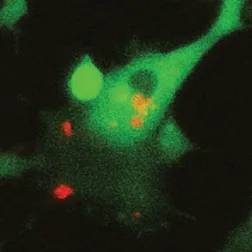- More than 2 years ago
Delivery of health-promoting genes into cells of the body holds enormous promise for preventing and treating diseases. However, the vehicles for those genes in current approaches to gene therapy are generally viruses or synthetic materials, including polymers. The former can elicit harmful immune responses, and the latter can be toxic (SN: 1/18/03, p. 43: Delivering the Goods). Now, biomedical engineers have devised a technique that uses metallic nanorods as gene carriers, which the researchers say could avoid those risks.

In the October Nature Materials, Kam Leong of Johns Hopkins University in Baltimore and his colleagues describe how they fabricated dual-metal rods measuring 200 nanometers in length and 100 nanometers in diameter. One half of the rod’s length is made of nickel; the other half is gold. To the nickel segment, the researchers attached DNA bearing a gene that coded for one of two proteins that make fireflies and some jellyfish glow. To the gold segment, the researchers attached a cell-targeting protein called transferrin.
When added to a lab dish containing cultured mammalian cells, the nanorods bound to receptors inside tiny pits on the cells’ surfaces. The pits then closed off and formed vesicles holding the nanorods. Carried into the cell in this way, the DNA eventually detached from the nanorods and entered the nucleus. There, the cell’s machinery translated the gene into the light-producing protein, indicating successful gene delivery and expression.
The Johns Hopkins team also delivered DNA into mice by using a so-called gene gun to propel small doses of the nanorods under the animals’ skin. After 1 day, the amount of glowing protein produced by the mice was similar to that needed for genetic vaccines, says Leong. This form of gene therapy delivers a single gene that produces a protein known to boost the body’s immune response to, say, a particular virus. In contrast, conventional vaccines deliver either a viral protein or a whole virus.
“I commend these researchers for trying to do this,” says gene-therapy researcher Mark Kay of Stanford University School of Medicine. Kay notes that many gene-delivery methods are under investigation and cautions that it’s too early to tell which might work in the clinic.
Leong aims to push forward the nanorod tactic. As a next step, he intends to build more-complex nanorods that will yield higher and more-sustained rates of gene expression, which would be necessary to treat diseases such as hemophilia and cystic fibrosis.
To increase gene expression, the Hopkins researchers plan to build nanorods with multiple segments using a variety of metals, such as platinum and silver. The surface chemistry of each metal is different, so the researchers can employ various metals to attach different types of biologically active molecules.
For instance, in addition to the DNA and transferrin molecules, a three-metal nanorod could bear a molecule that actively promotes the release of the nanorods from the vesicles into the main body of the cell, says Aliasager Salem, one of Leong’s coworkers. A specialized molecule attached to yet a fourth metal could target the nucleus. Because nickel is magnetic, researchers could use an external magnetic field to direct nickel-containing nanorods to specific parts of the body.
“The nicest thing about these nanorods is that we can systematically build up all the different aspects of a really good gene-delivery system,” says Salem.
****************
If you have a comment on this article that you would like considered for publication in Science News, send it to editors@sciencenews.org. Please include your name and location.





